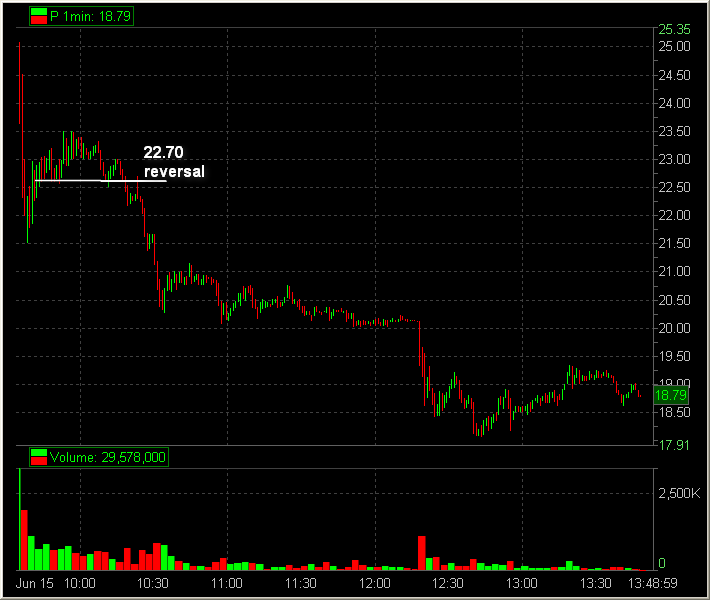I was hanging inside my office working on a new business idea for retail traders when the email below hit my inbox. I spent some time showing our new traders how you trade P in Real-Time, which was the catalyst for this ping. After P failed to hold 23 and then for the first time all AM held the offer at 22.70, I announced a likely move back to 20 intraday. 18 surprises me but not that much. Below 22.70 I saw a potential pattern that I recognized.
Ok so let’s share that email and then make my trading point.
Im watching P after our lecture and I think the estimate of 20 is too high. its bouncing around the low 20s right now but I see this stock going to the mid to low teens either today or tomorrow. fundies are bad b/c they have too much competition that offers either the same exact service minus the adds (last.fm), youtube, and the dozen or so music discovery services that pop up every day. their main source of revenue is adds in the music stream which is an intrusive method unlike something like an add next to a video. I feel this disadvantage alone will kill them.
You know I like all of this above. Makes sense to me. But too many investors/retail traders/newbs do not understand what their focus ought to be. This idea that 20 was coming next was not based on the facts or fundamentals above. It was based on those facts and fundamentals making it more likely for P to form a specific trading pattern. It was not that P would find lower ground because they had competition or some other fundamental reason. It was that these facts and fundamentals made it more likely that P would become an Exuberant, Excited Open IPO Waning Pattern.
This pattern is lots of buying because of hype and excitement followed by a waning interest. This pattern causes a pop and a run at higher highs that fails and then reverses hard. So I was not concerned about the right fundamental price of P. I was concerned that these fundamentals would cause P to fall into this pattern I have seen so often trading IPOs.
Traders trade patterns. Analysts wax poetic about proper price. Analysts offer opinions. Traders focus on gathering information from the market about what type of a pattern a stock most likely will form.
Mike Bellafiore
Author, One Good Trade


One Comment on “You are trading patterns not opinions”
I remember having trouble incorporating fundamental analysis as a short-term trader. But I have started thinking like how you are thinking in the post above. Here’s an example:
When a stock, typically a small cap, has poor fundamentals and everyone on stocktwits is short, I am thinking short squeeze. I will short it myself on certain technical patterns but I am also thinking long as well. This is what happened with ORS this week. A year ago, it was IFLG, which almost had the exact same pattern… spike, fail, spike fail, spike, hold, and long-awaited continuation (probably the result of a squeeze). Sadly, I was caught in the continuation on the short side for my first loss >1k, but have since learned my lesson.
When a stock beat earnings, I wasn’t sure how that could be a clear signal for me. Now I am trying to use that information to visualize a big picture outcome, rather than thinking of it as an explicit entry signal. If you’ve read Paul Tudor Jones’ chapter in More Money Than God, this is exactly what he does with fundamental analysis. He creates a fundamentals-based narrative, then waits for price action to confirm his idea. He describes this process when talking about his infamous short position during Black Monday. As many people know, he also relied on Elliot Wave Analysis as part of his “narrative”, rather than this entry signal, which explains how he was able to time the short without getting chopped up, since using Elliot Wave precisely would’ve led him to time the play too early.